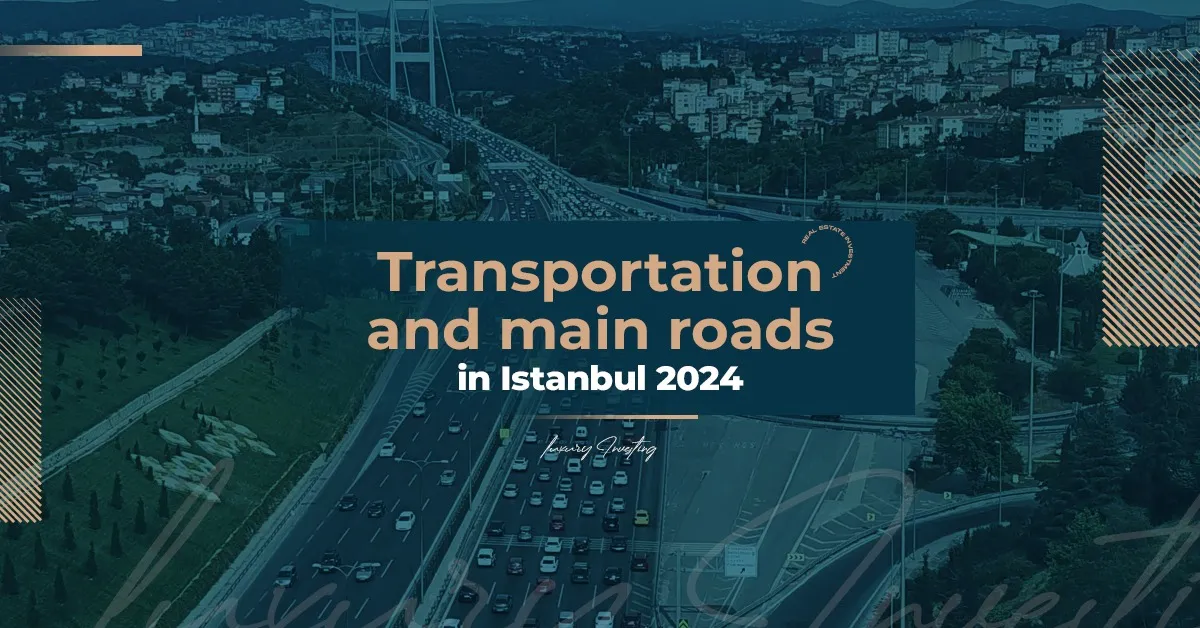
Transportation and main roads in Istanbul 2024: A comprehensive guide to moving around the city of Istanbul
Table of Contents
- The most important means of public transportation in Istanbul 2024
- Istanbul Metro: The mainstay of public transportation in the city
- Metrobus Istanbul: The lifeline of the vibrant city
- Istanbul Tram: A Journey Through History and the Present
- Water Ferries in Istanbul: An enchanting journey across the Bosphorus
- Buses in Istanbul: a vital transportation network that connects the city to each other
- Istanbul Card:
- Main roads in Istanbul:
- Future developments planned for major roads in Istanbul:
Istanbul, the city of Bosphorus, history and authenticity, is an important cultural and commercial center in the world, attracting millions of visitors annually. Istanbul is characterized by a comprehensive and diverse public transportation network that meets the needs of all visitors. Knowledge of the public transportation system and main roads is essential to ensure a smooth experience traveling within this charming and ancient city. Istanbul, the largest and most vibrant city in Turkey, is considered among the most crowded cities in the world, but nevertheless, it maintains a developed transportation system and a diverse road network that meets the needs of its residents and visitors. Transportation and main roads in Istanbul are vital to provide daily movement and access to multiple destinations in the city. In this article, we will take a comprehensive look at transportation and main roads in Istanbul during the year 2024.
The most important means of public transportation in Istanbul 2024
Istanbul Metro: The mainstay of public transportation in the city
The role of the Istanbul Metro is an essential pillar of the city's public transportation network. Istanbul Metro is considered an exemplary model of technological development in the field of transportation, and a representation of continuous efforts to improve the quality of life and facilitate movement in major cities.
The idea of establishing a metro system in Istanbul began to be realized in the late twentieth century, as the first metro line was opened in 1989, which connects the Taksim and Eminonu areas with an 8.5-kilometre track. Since then, Istanbul's metro network has witnessed tremendous growth, expanding to several lines covering most of the city's vital areas.
The Istanbul metro system currently consists of several main and branch lines linking different areas of the city. This system works to provide a quick and safe means of transportation for citizens and visitors, facilitating access to commercial, residential and tourist areas with ease.
The metro network in Istanbul extends over two main lines, the M1 (red line) and M2 (blue line), in addition to other branch lines. The metro connects the most important landmarks and vital areas in the city, such as Taksim, Sultanahmet, Beyoglu, and others.
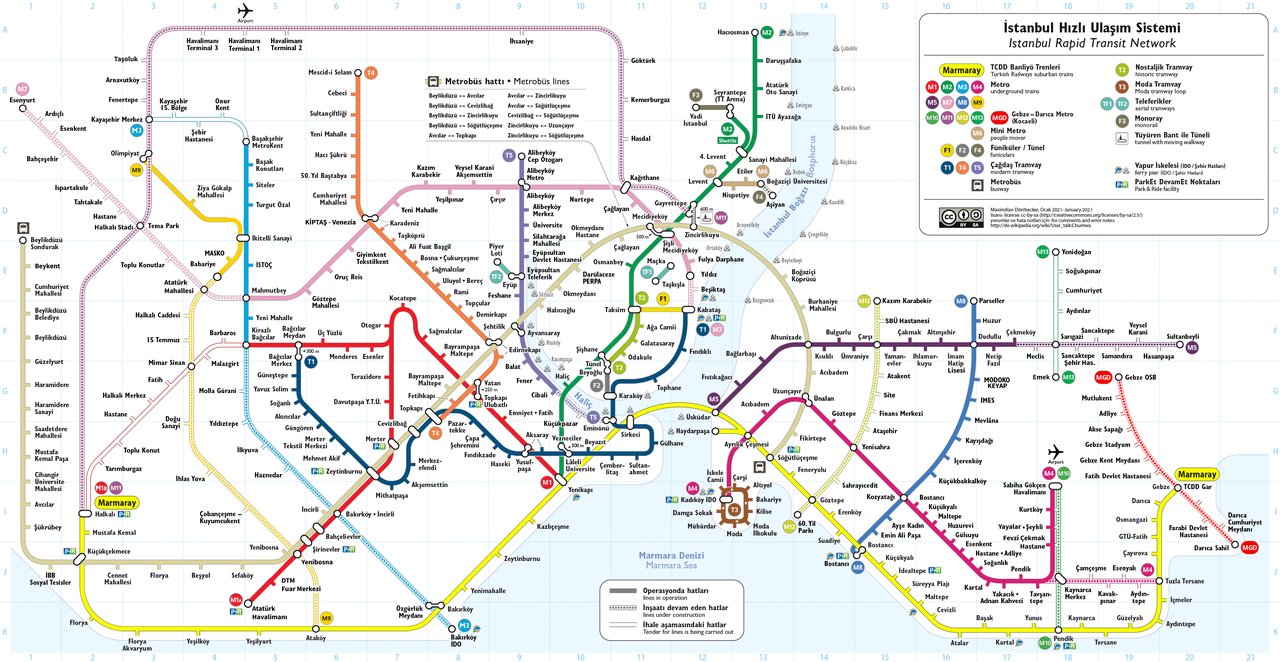
Yenikapi Istanbul Station
Yenikapi Istanbul station is one of the largest metro stations in Istanbul and goes to and from:
Istanbul Metro M1 metro line, which passes through many areas such as: Fatih, Topkapi, Zeytinburnu, Bakirkoy, and Sirinevler.
Istanbul Metro M2 line, which starts from Yenikapi station and passes through several areas such as: Taksim, Sisli, Levent and reaches the Haciosman area.
Kirazli Istanbul Station
The M3 Istanbul metro line departs from Kirazli Station, which passes through several important areas such as: Basaksehir, Bagcilar, Mahmutbey, and Basakevleri.
Mahmutbey Station
The M3 Istanbul metro line also starts from Mahmutbey Station, and intersects with the M7 metro line. It is worth noting that the M7 Istanbul metro line is the first fully automatic metro line, that is, without a driver, on the European side of the city.
New Istanbul Airport Metro
The new Istanbul Metro, the Istanbul Metro 2024, or the Istanbul M11 metro line, which connects the new airport to the city of Istanbul, is one of the most important infrastructure projects in the city, and it is the top concern of the Turkish government, which is keen to provide the highest standard of living and services for citizens and visitors.
Istanbul Sabiha Airport Metro Line
The Sabiha Airport metro line in Istanbul is the first line to be built for the airport, and it has made access to Sabiha Airport easier than before. This line connects Sabiha Airport to several important areas in Istanbul such as: Yenikapi, Pendik, Uskudar, Taksim, Kartal, and also passes through This line is from Sabiha Airport, Industrial Area, Yayalar, Hospital, Tavsantepe.
Metrobus Istanbul: The lifeline of the vibrant city
Metrobus is considered one of the most popular means of public transportation in Istanbul, as it consists of express bus lines with dedicated routes, making it a fast and efficient way to get around. The Metrobus connects the European and Asian sides of the city, and passes through many vital areas. The year 2002 witnessed the birth of the Metrobus Istanbul project, when the first line was opened, extending from Zincirlikuyu on the European section to sogutlucesme on the Asian section, with a length of 52 kilometers. The project quickly met with tremendous success, as it contributed to alleviating traffic congestion and improving transportation times for citizens. The Metrobus Istanbul system, which has become a lifeline that connects various parts of the city to each other efficiently and effectively, was created to meet the city's enormous transportation needs.
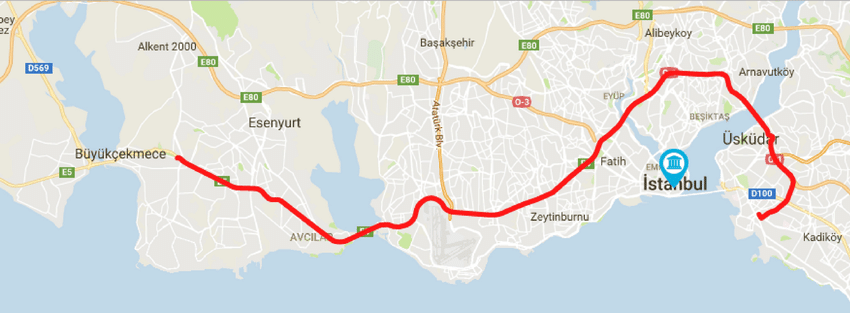
Metrobus Istanbul features:
- Travel speed: Metrobus Istanbul is very fast compared to other means of transportation, as buses run on dedicated lines away from traffic congestion, which reduces the trip time significantly.
- Punctuality: Metrobus buses operate according to a fixed schedule, ensuring that travelers reach their destination on time.
- Comfort: Metrobus buses have a modern and comfortable design, equipped with air conditioners and information displays, providing a comfortable travel experience for passengers.
- Safety: Metrobus Istanbul is a very safe transportation system. The buses are subject to strict safety standards, and their drivers have extensive experience.
- Cost: Metrobus Istanbul ticket prices are characterized by their reasonable cost, compared to other means of transportation, which makes them an economical option suitable for all categories.
- Ease of use: Using Metrobus Istanbul is very easy, as tickets can be purchased from Metrobus stations or through the Istanbul electronic card.
Metrobus Istanbul lines:
The Metrobus Istanbul system consists of 4 main lines:
- M1 line: It extends from Zincirlikuyu on the European section to sogutlucesme on the Asian section.
- M2 line: extends from Kadikoy on the Asian section to Yenibosna on the European section.
- M3 line: runs from Aydinpasa on the European section to metrokent on the European section.
- M4 line: extends from Tuzla on the Asian section to Catalca on the European section.
Istanbul Tram: A Journey Through History and the Present
Trams are one of the preferred means of transportation in the historical and commercial areas of Istanbul, such as Taksim and Beyoglu. They are distinguished by their classic design and routes that pass alongside famous tourist attractions. The Istanbul tram stands out as a symbol of the city's ancient civilization, connecting its various parts with a distinct flavor of nostalgia for the past. Istanbul's tram is one of the city's oldest transportation systems, dating back to 1871, when the first horse-drawn tram line was opened between Taksim and Besiktas. Over time, the tram network witnessed significant expansion, as many new lines were created that connected various parts of the city to each other.
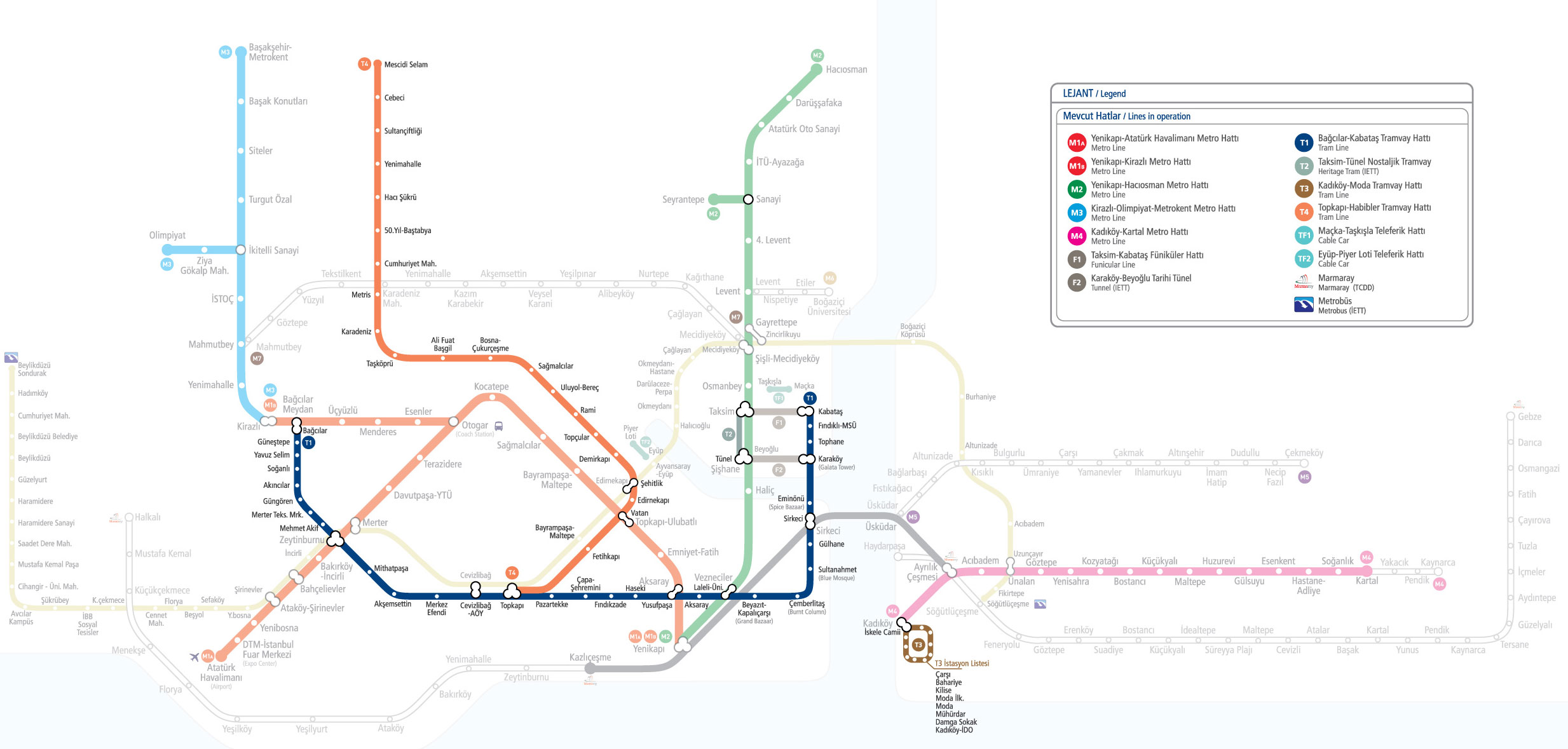
Istanbul Tram Features:
- A journey through time: The Istanbul tram features a classic design dating back to the early twentieth century, giving passengers a unique experience similar to time travel.
- Exploring the landmarks: The Istanbul tram passes through many of the city's famous historical and tourist attractions, such as Sultan Ahmed Mosque, Topkapi Palace, and Galata Tower, providing a wonderful opportunity to learn about Istanbul's ancient culture and history.
- A comfortable means of transportation: The Istanbul tram is characterized by being a comfortable and efficient means of transportation, as it runs on dedicated lines away from traffic congestion, ensuring a quiet and fast trip.
- A cultural experience: The Istanbul tram is more than just a means of transportation, but rather a unique cultural experience, as it allows passengers to interact with local people and learn about their customs and traditions.
- An environmentally friendly option: The Istanbul tram is an environmentally friendly means of transportation, as it runs on electricity, which contributes to reducing harmful emissions into the air.
Istanbul tram lines:
Istanbul's tram system consists of two main lines:
- T1 line: It extends from Kabatas on the European section to Sirkeci on the European section, passing through the famous Taksim area.
- T4 line: It extends from Kadikoy in the Asian section to the Zenit Theater in the European section, passing through the July 15 Martyrs Bridge area.
Water Ferries in Istanbul: An enchanting journey across the Bosphorus
The city of Istanbul is a jewel on the banks of the Bosphorus Strait, where history meets civilization, natural beauty and modern vitality. To fully experience the splendor of this city, it is necessary to ride one of the water ferries that roam the Bosphorus Strait, allowing passengers to enjoy viewing the charming city sights from a unique perspective. Ferries are a great way to travel between the two banks of the Bosphorus, and enjoy the stunning views of the city. Regular flights operate throughout the day, arriving at several stops along the Bosphorus.
Types of water ferries in Istanbul:
- Public ferries: These ferries are the most popular option, as they run on regular lines linking various parts of the city, and are distinguished by their reasonable cost and large capacity.
- Tourist ferries: These ferries offer distinctive cruises with a guided explanation of the landmarks along the strait, and are distinguished by their luxurious design and distinctive services, such as providing comfortable seats, food and drink, which makes them an ideal choice for luxury lovers.
- Private Ferries: These ferries allow passengers to enjoy a cruise customized to their desires, characterized by complete privacy and freedom to choose the itinerary.
Water ferry lines in Istanbul:
The water ferry network in Istanbul covers various parts of the city, with main lines linking:
- Eminonu and Kadikoy: This line is one of the busiest lines, as it connects the European and Asian sides of the city.
- Besiktas and Uskudar: This line offers a beautiful cruise along the Bosphorus Strait, with stunning views of Dolmabahce Palace and the July 15 Martyrs Bridge.
- Eminonu and Ortakoy: This line passes near many famous tourist attractions, such as Sultan Ahmed Mosque and Galata Tower.
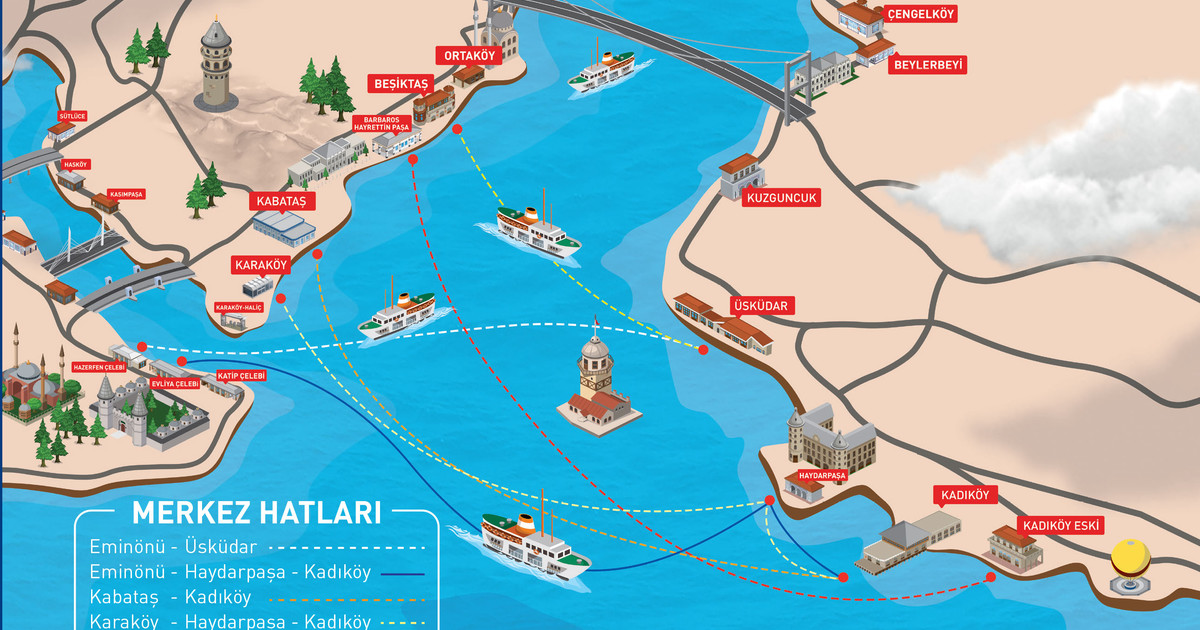
Advantages of water ferries in Istanbul:
- Enjoy the stunning views: Water ferries allow passengers to enjoy Istanbul's charming landmarks from a unique perspective, such as the palaces of the Ottoman sultans, the city's suspension bridges, and the stunning landscapes of the Bosphorus Strait.
- Escape from traffic: Water ferries are an ideal option to avoid traffic in Istanbul, as they provide a quick and easy cruise between different parts of the city.
- A distinctive cultural experience: Water ferries give passengers the opportunity to learn about Istanbul’s culture and ancient history, by seeing the tourist attractions and listening to the guide’s explanation.
- Family-friendly option: Many water ferries offer designated areas for children, making them an ideal choice for spending quality time with the family.
The best times to enjoy a cruise in Istanbul:
- Sunset: A sunset ferry ride is an enchanting experience, as the sunset colors give the city a special charm.
- Spring or autumn: These two seasons are characterized by mild climates and picturesque landscapes, which make the ferry trip more enjoyable.
- Weekdays: Ferries are less crowded on weekdays, providing a quieter and more comfortable journey.
*Important tips:
- Book tickets in advance especially in peak seasons to avoid crowds.
- It is recommended to wear comfortable clothing appropriate to the weather conditions.
Buses in Istanbul: a vital transportation network that connects the city to each other
Buses cover all parts of Istanbul and are an economical option for long-distance transportation. Istanbul's bus network covers all parts of the city, with more than 500 bus routes reaching more than 15.000 stations, ensuring easy access to any destination within the city.
Istanbul Card:
The Istanbul Card (Istanbul Kart) makes it easy to use public transportation, as it is used to pay for all types of transportation, including the metro, metrobus, trams, ferries, and buses.
Main roads in Istanbul:
Istanbul, the beating heart of Turkey and one of the largest cities in the world, has a diverse and complex road network that reflects its cultural diversity and rich history. Istanbul's main roads are not only means of transportation, they are also vital landmarks that reflect the fabric of the city and tell its multi-faceted story. To meet the city's massive mobility needs, an extensive network of major roads has been created that are the transportation arteries that keep the city vibrant.
The most important main roads in Istanbul
TEM Road (E80):
TEM Road is one of the newest major highways in Istanbul, running through the European section of the city. This road is considered an important traffic corridor, as it connects the northern and southern areas of the city, and helps relieve congestion on traditional roads. In addition, TEM Road provides easy access to important shopping, business centers and residential areas in Istanbul. It connects Sabiha Gokcen International Airport to the city center, and extends north to Bursa. This road connects Istanbul with Europe, and passes through many Turkish cities. This road is considered one of the most important roads in Istanbul, as it connects the European and Asian sides of the city via the July 15 Martyrs' Bridge, and extends east to Iran and west to Bulgaria.
E5 Road (D100):
This road is one of the main roads on the European side of Istanbul, and it extends from the Buyukcekmece area all the way to the Fatih area in the heart of European Istanbul. This road is considered the main artery in Istanbul, and passes through the European and Asian sides of the city. This road is one of the busiest roads in Istanbul, as it connects Ataturk International Airport to the city center, and extends north to the Kadikoy area on the Asian side.
O-7 Road:
This road connects Ataturk International Airport to the city center.
July 15 Martyrs Bridge (Bosphorus Bridge):
This suspension bridge is one of the longest bridges in the world, linking the European and Asian sides of the city. The Bosphorus Bridge is considered one of the most prominent landmarks in Istanbul, as it connects the European and Asian sides of the city. The bridge has a very strategic location, as it is a vital traffic route between the eastern and western banks of the city.
Marmaray Tunnel:
This underwater tunnel is the longest vehicular tunnel in the world, connecting the European and Asian sides of the city.
Future developments planned for major roads in Istanbul:
- Road expansion projects: The Turkish government is implementing several major road expansion projects in Istanbul, with the aim of relieving traffic congestion and improving traffic.
- Public transportation projects: The Turkish government plans to develop the public transportation network in Istanbul, by establishing more metro and bus lines, with the aim of reducing dependence on private cars.
- Infrastructure improvement projects: The Turkish government is implementing several infrastructure improvement projects on the main roads in Istanbul.
Frequently asked questions
The new Istanbul Metro, the Istanbul Metro 2024, or the Istanbul M11 metro line, which connects the new airport to the city of Istanbul, is one of the most important infrastructure projects in the city, and it is the top concern of the Turkish government, which is keen to provide the highest standard of living and services for citizens and visitors.
The Sabiha Airport metro line in Istanbul is the first line to be built for the airport, and it has made access to Sabiha Airport easier than before. This line connects Sabiha Airport to several important areas in Istanbul such as: Yenikapi, Pendik, Uskudar, Taksim, Kartal, and also passes through This line is from Sabiha Airport, Industrial Area, Yayalar, Hospital, Tavsantepe.
It is recommended to deal with real estate agents who speak English or to hire a certified legal translator to ensure that all terms and conditions are clearly understood.
Maintenance costs vary depending on the type of property and the residential complex. They typically include cleaning costs, security, gardening, and shared facilities such as swimming pools or sports clubs.
The city of Istanbul is a jewel on the banks of the Bosphorus Strait, where history meets civilization, natural beauty and modern vitality. To fully experience the splendor of this city, it is necessary to ride one of the water ferries that roam the Bosphorus Strait, allowing passengers to enjoy viewing the charming city sights from a unique perspective. Ferries are a great way to travel between the two banks of the Bosphorus, and enjoy the stunning views of the city. Regular flights operate throughout the day, arriving at several stops along the Bosphorus.








